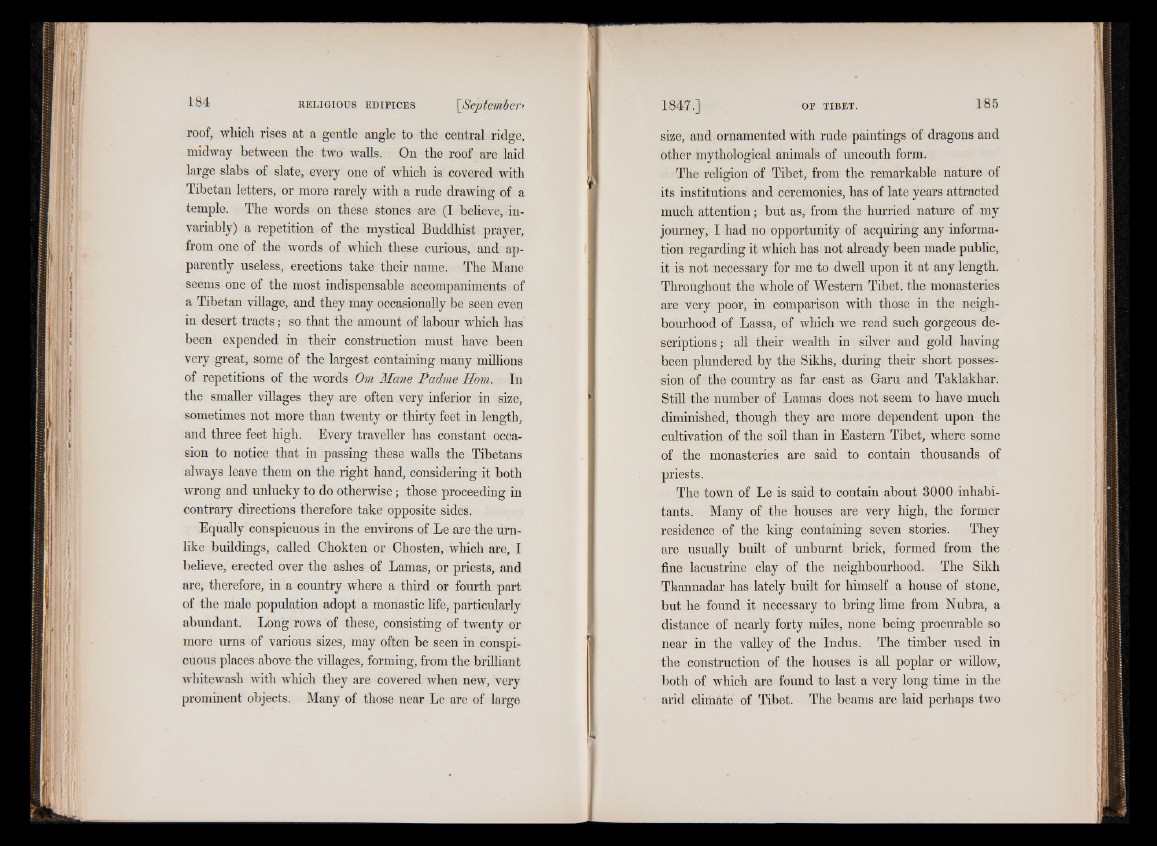
roof, which rises at a gentle angle to the central ridge,
midway between the two walls. On the roof are laid
large slabs of slate, -every one of which is covered with
Tibetan letters, or more rarely with a rude drawing of a
temple. The words on these stones are (I believe, invariably)
a repetition of the mystical Buddhist prayer,
from one of the words of which these curious, and apparently
useless, erections take their name. The Mane
seems one of the most indispensable accompaniments of
a Tibetan village, and they may occasionally be seen even
in desert tracts; so that the amount of labour which has
been expended in their construction must have been
very great, some of the largest containing many millions
of repetitions of the words Om Mane Padme Horn. In
the smaller villages they are often very inferior in size,
sometimes not more than twenty or thirty feet in length,
and three feet high. Every traveller has constant occasion
to notice that in passing these walls the Tibetans
always leave them on the right hand, considering it both
wrong and unlucky to do otherwise; those proceeding in
contrary directions therefore take opposite sides.
Equally conspicuous in the environs of Le are the urn-
like buildings, called Chokten or Chosten, which are, I
believe, erected over the ashes of Lamas, or priests, and
are, therefore, in a country where a third or fourth part
of the male population adopt a monastic life, particularly
abundant. Long rows of these, consisting of twenty or
more urns of various sizes, may often be seen in conspicuous
places above the villages, forming, from the brilliant
whitewash with which they are covered when new, very
prominent objects. Many of those near Le are of large
size, and ornamented with rude paintings of dragons and
other mythological animals of uncouth form.
The religion of Tibet, from the remarkable nature of
its institutions and ceremonies, has of late years attracted
much attention ; but as, from the hurried nature of my
journey, I had no opportunity of acquiring any information
regarding it which has not already been made public,
it is not necessary for me to dwell upon it at any length.
Throughout the whole of Western Tibet, the monasteries
are very poor, in comparison with those in the neighbourhood
of Lassa, of which we read such gorgeous descriptions
; all their wealth in silver and gold having
been plundered by the Sikhs, during their short possession
of the country as far east as Garu and Taklakhar.
Still the number of Lamas does not seem to have much
diminished, though they are more dependent upon the
cultivation of the soil than in Eastern Tibet, where some
of the monasteries are said to contain thousands of
priests.
The town of Le is said to contain about 3000 inhabitants.
Many of the houses are very high, the former
residence of the king containing seven stories. They
are usually built of unburnt brick, formed from the
fine lacustrine clay of the neighbourhood. The Sikh
Thannadar has lately built for himself a house of stone,
but he found it necessary to bring lime from Nubra, a
distance of nearly forty miles, none being procurable so
near in the valley of the Indus. The timber used in
the construction of the houses is all poplar or willow,
both of which are found to last a very long time in the
arid climate of Tibet. The beams are laid perhaps two